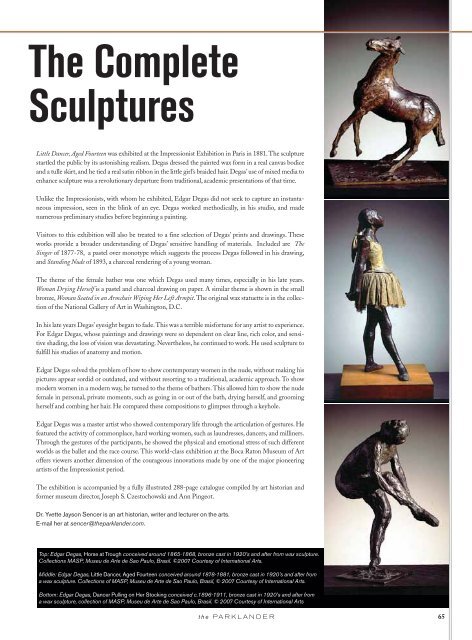February 2008 - The Parklander Magazine
February 2008 - The Parklander Magazine
February 2008 - The Parklander Magazine
- No tags were found...
You also want an ePaper? Increase the reach of your titles
YUMPU automatically turns print PDFs into web optimized ePapers that Google loves.
ARTS&ENTERTAINMENT<strong>The</strong> CompleteSculpturesLittle Dancer, Aged Fourteen was exhibited at the Impressionist Exhibition in Paris in 1881. <strong>The</strong> sculpturestartled the public by its astonishing realism. Degas dressed the painted wax form in a real canvas bodiceand a tulle skirt, and he tied a real satin ribbon in the little girl’s braided hair. Degas’ use of mixed media toenhance sculpture was a revolutionary departure from traditional, academic presentations of that time.Unlike the Impressionists, with whom he exhibited, Edgar Degas did not seek to capture an instantaneousimpression, seen in the blink of an eye. Degas worked methodically, in his studio, and madenumerous preliminary studies before beginning a painting.Visitors to this exhibition will also be treated to a fine selection of Degas’ prints and drawings. <strong>The</strong>seworks provide a broader understanding of Degas’ sensitive handling of materials. Included are <strong>The</strong>Singer of 1877-78, a pastel over monotype which suggests the process Degas followed in his drawing,and Standing Nude of 1893, a charcoal rendering of a young woman.<strong>The</strong> theme of the female bather was one which Degas used many times, especially in his late years.Woman Drying Herself is a pastel and charcoal drawing on paper. A similar theme is shown in the smallbronze, Woman Seated in an Armchair Wiping Her Left Armpit.<strong>The</strong> original wax statuette is in the collectionof the National Gallery of Art in Washington, D.C.In his late years Degas’ eyesight began to fade.This was a terrible misfortune for any artist to experience.For Edgar Degas, whose paintings and drawings were so dependent on clear line, rich color, and sensitiveshading, the loss of vision was devastating. Nevertheless, he continued to work. He used sculpture tofulfill his studies of anatomy and motion.Edgar Degas solved the problem of how to show contemporary women in the nude, without making hispictures appear sordid or outdated, and without resorting to a traditional, academic approach. To showmodern women in a modern way, he turned to the theme of bathers.This allowed him to show the nudefemale in personal, private moments, such as going in or out of the bath, drying herself, and groomingherself and combing her hair. He compared these compositions to glimpses through a keyhole.Edgar Degas was a master artist who showed contemporary life through the articulation of gestures. Hefeatured the activity of commonplace, hard working women, such as laundresses, dancers, and milliners.Through the gestures of the participants, he showed the physical and emotional stress of such differentworlds as the ballet and the race course. This world-class exhibition at the Boca Raton Museum of Artoffers viewers another dimension of the courageous innovations made by one of the major pioneeringartists of the Impressionist period.<strong>The</strong> exhibition is accompanied by a fully illustrated 288-page catalogue compiled by art historian andformer museum director, Joseph S. Czestochowski and Ann Pingeot.Dr. Yvette Jayson Sencer is an art historian, writer and lecturer on the arts.E-mail her at sencer@theparklander.com.Top: Edgar Degas, Horse at Trough conceived around 1865-1868, bronze cast in 1920’s and after from wax sculpture.Collections MASP, Museu de Arte de Sao Paulo, Brasil. ©2007 Courtesy of International Arts.Middle: Edgar Degas, Little Dancer, Aged Fourteen conceived around 1878-1881, bronze cast in 1920’s and after froma wax sculpture. Collections of MASP, Museu de Arte de Sao Paulo, Brasil, © 2007 Courtesy of International Arts.Bottom: Edgar Degas, Dancer Pulling on Her Stocking conceived c.1896-1911, bronze cast in 1920’s and after froma wax sculpture, collection of MASP, Museu de Arte de Sao Paulo, Brasil. © 2007 Courtesy of International Artsthe PARKLANDER65
















